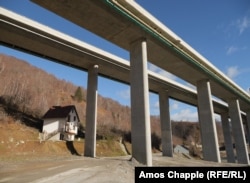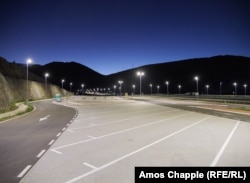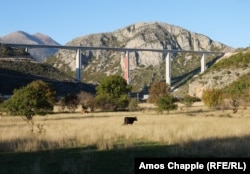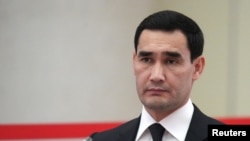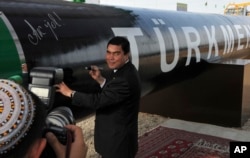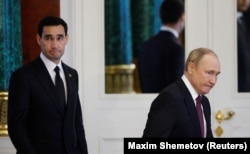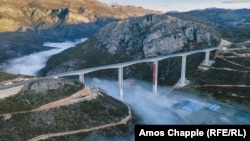
PODGORICA -- It took eight years of construction, delays, and controversy, but Maria Kovijanic, who runs a small store along a stretch of a new $1 billion Chinese-funded highway outside the Montenegrin capital, is ready to reap the project's promised benefits.
Valued as one of the world's most expensive roads, the first 41 kilometers opened in July 2022 and cuts through Montenegro's soaring mountains and over its deep gorges, with an estimated 60 percent of the highway made up only of tunnels and bridges. For a toll fee of 3.50 euros ($3.75), a previously arduous journey north has been turned into a roughly 25-minute trip along freshly paved asphalt until the stretch of road peters out at Matesevo, the village where Kovijanic runs her shop.
She says the new, modern road is a game changer for her and other residents that live and own businesses along the highway, with the new section dramatically cutting down travel times and providing an alternative to previously congested and treacherous mountain roads in the small Balkan country of 620,000 people.
"People here like [the highway] because it's a shorter way to Podgorica. Before we were going the long way through the canyon of Moraca," Kovijanic said. "A lot of people died on that road, so we are very happy with this highway."
Under the original plan inked in 2014, the initial 41 kilometers -- which was funded by a loan from the Export-Import Bank of China and built by the China Road and Bridge Corporation (CRBC) -- was to be part of a 163-kilometer highway to link the Montenegrin port city of Bar with neighboring Serbia. The project promised to transform the country into a transport hub for the wider region and bolster economic activity in the process.
But the highway has found itself marred in scandal and still faces lingering questions about whether the remaining 122 kilometers of road will ever be completed.
The road project has also brought long-term economic risk by saddling Montenegro with debts to China that totaled more than one-third of the annual state budget, with the controversial venture being a prime example of what critics say are cursory Chinese lending practices fused with local corruption.
Despite this controversy, polls have shown that only a minority in Montenegro see China or the financial risk brought by the highway as a concern, with many instead hoping that both will provide an economic boost to the country.
"[The highway] is expensive, yes, but we needed this route," Kovijanic said. "If they [are able to] connect this highway with Serbia, [it] will be the best."
Grappling With A Price Tag
Once hailed as an early success of Beijing's Belt and Road Initiative -- the globe-spanning infrastructure initiative launched in 2013 by Chinese leader Xi Jinping -- the highway has since become a cautionary tale for how ambitious construction projects can go wrong.
The loan was taken out by a previous government led by current President Milo Djukanovic, who continues to be a dominating force in the country's politics.
Because Podgorica didn't hedge against currency swings and failed to include a turnpike in its original plans, the cost of the project continued to soar over the years, leading to the current debt problem and the ballooned $1 billion price tag attached to the first stretch of the highway.
The project was also controversial from the start among local civil-society groups and the country's opposition, with the Network for Affirmation of the Nongovernmental Sector (MANS), a Balkan watchdog organization, raising corruption and transparency concerns over how construction contracts were distributed to Chinese and local companies.
Questions over total cost and how the project would generate revenue have also followed the highway since its conception. Under a new government in 2021, Montenegro's Capital Investments Ministry published two previously confidential international feasibility studies, which suggest that the estimated cost of the first phase of the highway was greatly exaggerated. One of those studies, compiled by British consultancy Scott Wilson Group, said it should cost $570 million, a little more than half of the current cost.
This debt incurred from the highway also brought Podgorica to the edge of collapse and the country's leadership has since received relief and restructuring from a group of European and U.S. banks as Montenegro begins to repay its debt to China.
Environmental concerns also followed its construction, with CRBC accused of damaging sections of the riverbank along the UNESCO-protected Tara River traversed by the highway, which Montenegro's Nature and Environmental Protection Agency (NEPA) said was raised with the Chinese builders, but ignored.
That laundry list of concerns looks set to follow the highway now that it's open.
While many locals along the road say that the highway was busy in the summer, nearly six months after its launch the traffic appears to be light. Many roadside signs that show icons advertising shops, water, gas, and other services in rest stops are also now crossed out, highlighting a lower-than-expected demand.
Still, many Montenegrins believe that the highway can improve their lives.
Milan Kalezic, who runs a tourism driving service in Podgorica, says that the stretch of road will be a boost for his industry by allowing easier and more direct access to ski resorts and better connections to smaller villages in the mountains, which could lead to greater community-based tourism in the country.
"Now with the new highway, sometimes I take guests [to villages accessed by the highway] just for the food," Kalezic said. "Sometimes I go by myself [or] with my family just to have dinner."
Down The Road
Emerging from years of delays, scandals, and a debt crisis, the big question surrounding the highway is whether it can be completed as originally conceived.
At the opening ceremony in July 2022, which was attended by representatives from CRBC and the Chinese Embassy in Podgorica, Prime Minister Dritan Abazovic spoke highly about the project's potential.
"This investment will undoubtedly open up new directions of development and give the strongest impetus to the domestic economy," he said. "The highway is the beginning of the permanent connection of Montenegro with the world."
The highway itself is divided into three sections, and the current government has said that it hopes to finish building the full length of the highway and is reportedly exploring funding options with European lenders.
An estimate released last year by the Capital Investments Ministry said the 23.5-kilometer-long second section of the road -- which would run from Matesevo to Andrijevica in eastern Montenegro -- would cost approximately $590 million.
Vladimir Shopov, an expert on China's role in the Balkans at the European Council on Foreign Relations, says that both Podgorica and China will be looking to keep some distance from one another for the near future following years of scandal.
Many questions still remain from this period. The 2014 loan agreement with the Export-Import Bank of China has been made public, but nearly all other documents relating to the highway have been classified as secret by Podgorica, which many experts believe is due to binding clauses in the Chinese contracts.
"There is a transparency trap here," Shopov said. "Very few people actually know everything that exists in the contracts."
While that raises potentially further worrying implications for Montenegro should it face more economic strain again in the future, Shopov says that he doesn't rule out new infrastructure or investment from China in Montenegro down the line.
"Despite all the bad press, the Chinese don't back away," he said. "Montenegro also has few alternatives."




